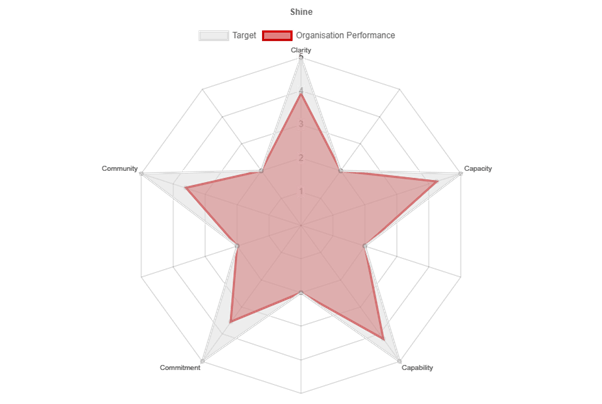Can We Predict A Company's Future Performance?
A track record of excellent performance is important but cannot guarantee future results. There are many examples of companies that, after performing exceptionally for years, have fallen on hard times. Organizational health and performance are the ultimate lag objectives. The criteria agreed for assessing such can only be measured and evaluated at an agreed point in time in the future, for example, at the organization's 2021 or 2022 financial year-end.
To predict an organization's potential for future sustainable success requires the identification of the lead indicators that combine to deliver organizational health and performance. The diagram below depicts the two systems that need to be aligned, through organizational Clarity, to work in synch to deliver sustainable organizational health and performance. The 5 dimensions of organizational health and performance (5C model) can then be further factored into 15 lead indicators for organizational health and performance as shown below:
The 5 dimensions of organizational health and performance (5C model) can then be further factored into 15 lead indicators for organizational health and performance as shown below:

To deliver sustainable organizational health and performance, so that organizations continue to shine and not lose their luster, requires the ongoing measurement/assessment of all of these lead indicators, as well a commitment to take corrective/developmental action as required. This is especially important during and in the wake of the kind of disruption caused by COVID-19.
Many organizations have "battened down the hatches" and are doing their best to weather the COVID-19 storm. It is hoped that the spread of the virus will be brought under control and that an effective vaccine will be found. As such, many anticipate that at some stage in 2021, we will see the return of "a reasonable level of normality." But, have captains of industry assessed potential systemic damage to their organizations, as well as how ready their people are feeling for 2021? Can leaders confidently tell their stakeholders that they have done so and that they are doing what needs to be done to perform well in 2021?
A Case Study Of An Organization That Is Doing What Needs To Be Done To Be Ready For 2021
The organization under discussion has exceptional leadership and an excellent performance track record. In addition, it adjusted and made the changes required to continue to deliver throughout the challenges brought on by COVID-19. But, what is needed to be done to ensure that this organization (which will remain anonymous) will be ready to continue its stellar performance in 2021?
It was agreed that two assessments were required to ensure that the organization would be healthy and ready to perform optimally in 2021. Firstly, the 5 dimensions that are required to be aligned and work in synch to achieve sustainable organizational health and performance would be assessed to determine readiness to land strongly in 2021. This process was explained in a recent article, "Leaders: Listen To The Digital Heartbeat™ Of Your Organization." Secondly, the capability levels of staff across the 5 capability sets required for sustainable individual and team performance would be assessed. This process was explained in another article, "To Survive And Prosper: The Complete Capability Set Imperative.
Organizational Readiness
All members of the organization were briefed on why the organizational assessment was being done, how it would be done, how the results would be presented, and what action would be taken as a result of the assessment.
The SHINE diagnostic questionnaire was loaded onto the LMS and all employees were requested to complete it. Responses were anonymous. As the results were gathered, they were immediately available on the LMS for each division and for the entire organization. Each employee had access to the results for their division and for the entire organization. The results for the entire organization are shown below: The results were consistent across all divisions and in fact mirrored the results shown above for the total organization. It will be noted that the organization's performance systems (consisting of organizational capacity and capability) have remained strong. However, it can be seen that there are opportunities for improvement when it comes to Clarity and the human systems (consisting of a sense of community and commitment). The understanding of this is contextualized in the first diagram shown in this article, which depicts the two systems that must be aligned and operate in synch to optimize organizational health and performance.
The results were consistent across all divisions and in fact mirrored the results shown above for the total organization. It will be noted that the organization's performance systems (consisting of organizational capacity and capability) have remained strong. However, it can be seen that there are opportunities for improvement when it comes to Clarity and the human systems (consisting of a sense of community and commitment). The understanding of this is contextualized in the first diagram shown in this article, which depicts the two systems that must be aligned and operate in synch to optimize organizational health and performance.
On interrogating the system for specifics, it would seem that COVID-19 has taken its toll on this organization in a number of areas. It is possible to speculate that this is due to the levels of disengagement caused by employees working remotely as well as the general levels of uncertainty and stress that COVID-19 has caused. However, it could also be that there were already systemic faults which were simply opened up by the onslaught of the effects of COVID-19.
- In the Clarity dimension, employee feedback indicated that they felt that leadership was not being clear enough on the specific actions/behaviors that were expected of them for the organization to continue to be successful.
- In the sense of Community dimension, employees reported that they felt that they did not have influence over things that mattered to them. Also, from a sense of community perspective, employees felt that their colleagues were not putting enough effort into being "good people to work with" and that leadership needed to be clearer about new ways of interacting for comfortable ways of working together. Also, relevant to the sense of community was a sense from employees that their contributions were not being noticed.
- Regarding Commitment, trust seemed to have been diluted from two perspectives. Firstly, employees felt that leadership was not identifying and quickly and fairly resolving issues. And secondly, employees were reluctant to acknowledge when they needed help or disagreed with something.
The leadership of the organization has reported back to employees on the specific issues identified and internal facilitators have been appointed and trained to work with employees and leadership to resolve these issues. There is a sense of optimism that these issues will be resolved and that the organization will land in a strong, healthy position in 2021 and be able to continue its track record of excellent performance.
It is important to note that, if these issues had not been systematically and specifically identified and a plan made to deal with them, both the health and the performance of the organization could have been compromised going forward.
Employee Readiness
The second part of the exercise, again using diagnostic questionnaires set up on the LMS, involved all employees doing a self-assessment of their 5 capability sets as well as getting 360-degree feedback from colleagues. This feedback was portrayed graphically for each employee, showing both their self-assessment and the 360-degree feedback from colleagues separately. Below is an unpopulated example of how the feedback was shown so that it was easy to see the degree to which self-assessment and 360-degree feedback aligned:

Where there was an opportunity for development in a capability set, the system identified specific capabilities that required attention. Each employee identified between one and three specific capabilities that they would work on for the balance of the year. It was agreed that the capabilities that they identified would enable them to contribute more effectively to the organization's Purpose and/or being a more effective team member. Each person shared these opportunities with their team and they committed to give each other updates and feedback at regular team meetings.
"Mirror, Mirror On The Wall"
The leader of this organization shared the results of the diagnostic surveys as well as the action plans with the various stakeholders and exuded confidence that the organization would land strongly in 2021 to continue its excellent track record.
Stakeholders are confident that this is an organization that will continue to perform exceptionally. In fact, this is the type of organization that most people would feel comfortable investing in.






